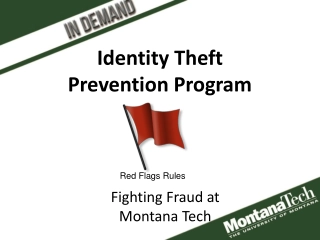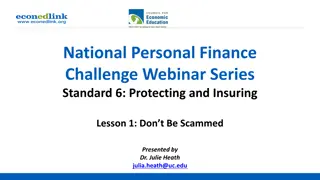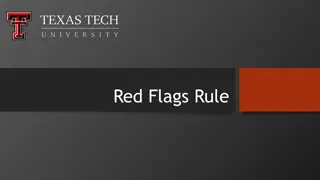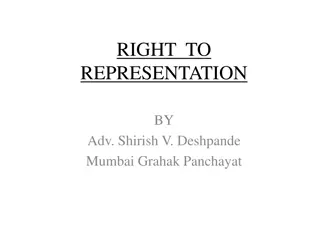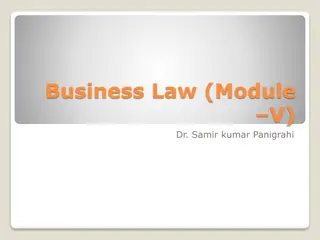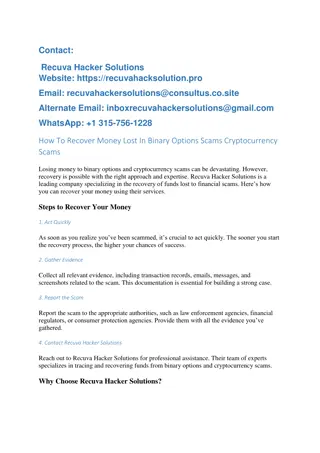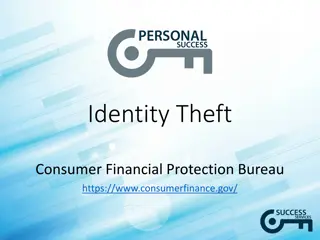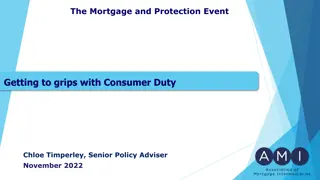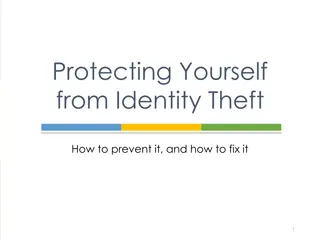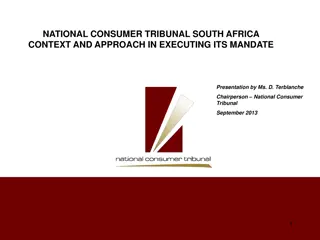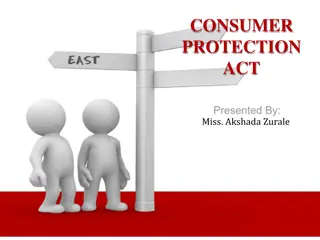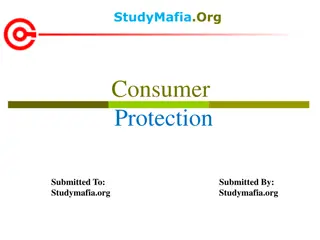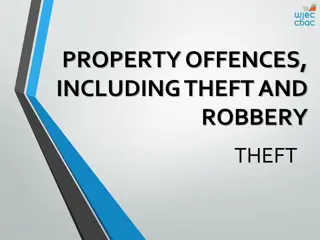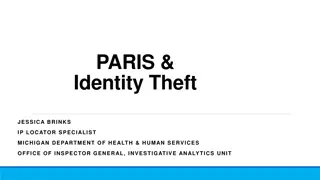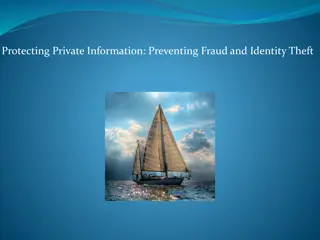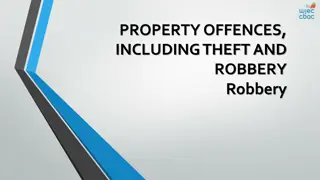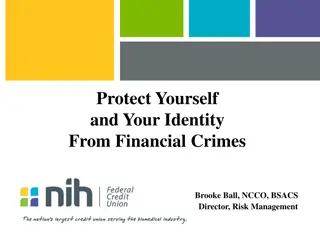Protect Yourself: Identity Theft and Consumer Protection Insights
Explore the realms of identity theft, consumer protection laws, and fraud prevention strategies. Learn about consumer rights and responsibilities, ways to avoid financial scams, and agencies providing assistance. Discover the importance of safeguarding personal information to prevent fraud and identity theft.
Download Presentation

Please find below an Image/Link to download the presentation.
The content on the website is provided AS IS for your information and personal use only. It may not be sold, licensed, or shared on other websites without obtaining consent from the author. Download presentation by click this link. If you encounter any issues during the download, it is possible that the publisher has removed the file from their server.
E N D
Presentation Transcript
Identity Theft & Consumer Protection
Fraud Quiz Identity Fraud Quiz <strong>Identity-Theft</strong>-Online - Ethics How to defend yourself against Fraud
Questions to Consider What are consumers rights and responsibilities? What is the purpose of consumer protection laws and agencies? How can I avoid identity theft and fraud? How do I understand financial contracts? What are ways to avoid financial scams?
Consumer Rights & Responsibilities RIGHTS RESPONSIBILITIES To Safety To Use Products Safely To Be Informed To Seek Information and Use it to make Decisions To Choose To Choose Goods and Services Carefully To Be Heard To Speak Up and Let Likes and Dislikes Be Known Consumer Bill of Rights (State of the Union Address of 1962, President John F. Kennedy) Source: Thomson South-Western, Economic Education for Consumers; USOE Adult Roles & Responsibilities
Agencies & Sources of Assistance Food & Drug Administration (FDA) Consumer Product Safety Commission (CPSC) Federal Trade Commission (FTC) Better Business Bureau (BBB) Bureau of Consumer Protection (BCP) Consumer Unions (Consumer Product-Testing Organizations) Source: USOE Adult Roles & Responsibilities Curriculum
Who Protects Savers? Credit Unions Banks
Identity Theft True-name Fraud Someone wrongfully acquires and uses a consumer s personal identification, credit, or account information without your permission. They may ask for this information: Social Security Numbers Name Address Date of Birth Mother s Maiden Name Passwords PINs
Fraud A deliberate deception, designed to secure unfair or unlawful gain. ( Cheating the Consumer )
Ways to Avoid Identity Theft Monitor your credit report. Don t give out personal information to unknown people or companies. Protect your credit and debit cards. Protect your mailbox. Protect your wallet. Use passwords and PINs that cannot be easily guessed. Use anti-virus software on your computer. Notify your bank when you change your address or phone number.
Respond to the following scenarios based on what you have learned. Bethany purchased a new pair of shoes from the Internet. What steps should she take to ensure her identity was protected while making the purchase? Source: FEFE 3.1
Respond to the following scenarios based on what you have learned. Dana went out to dinner and left her credit card there. The next day she called the restaurant and they said they didn t have the card. What should she do? Source: FEFE 3.1
Respond to the following scenarios based on what you have learned. Jacob has just finished writing bills. What steps should he take to ensure the bills reach their destination safely? Source: FEFE 3.1
Respond to the following scenarios based on what you have learned. Sam purchased a bicycle on credit. When he received his credit card statement, he noticed several charges he did not make. What should he do? Source: FEFE 3.1
Disclosure Information Provides full information about a financial institution s policies. Such as electronic funds transfer policies, lending policies, interest crediting, and compliance with banking regulations. These statements are required by law.
Grace Period The time between the billing date and the payment due date when no interest is charged.
Late Payment Penalties Late Fees Finance Charges Increased Interest Rate
Method of Interest Calculation Average daily balance excluding new purchases Average daily balance including new purchases with a grace period Average daily balance including new purchases with no grace period Two-cycle average daily balance including new purchases
Tips To Help Dump Debt Write it down Make a list of how much money you owe and the interest rate. Start the snowball rolling Pick the debt with the highest interest rate and put extra cash toward that balance. Negotiate a repayment schedule. Cut it out Select an activity and stop it for a month or two, put it toward the debt. Or, sell assets. Don t forget to save Start saving, even if it s a small amount every week. Source: NEFE
Concerning interest on debt Interest never sleeps nor sickens nor dies; It never goes to the hospital; It works on Sundays and holidays; It never takes a vacation; It never visits or travels; It takes no pleasure; It is never laid off work nor discharged from employment; It never works on reduced hours
Quote Once in debt, interest is your companion every minute of the day and night; you cannot shun it or slip away from it; you cannot dismiss it; it yields neither to entreaties, demands, or orders, and whenever you get in its way or cross its course or fail to meet its demands it crushes you. ~ J. Ruben Clark


